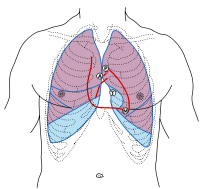
Photo from wikipedia
Asthma and chronic obstructive pulmonary disease (COPD) patients are required to inhale forcefully and deeply to receive medication when using a dry powder inhaler (DPI). There is a clinical need… Click to show full abstract
Asthma and chronic obstructive pulmonary disease (COPD) patients are required to inhale forcefully and deeply to receive medication when using a dry powder inhaler (DPI). There is a clinical need to objectively monitor the inhalation flow profile of DPIs in order to remotely monitor patient inhalation technique. Audio-based methods have been previously employed to accurately estimate flow parameters such as the peak inspiratory flow rate of inhalations, however, these methods required multiple calibration inhalation audio recordings. In this study, an audio-based method is presented that accurately estimates inhalation flow profile using only one calibration inhalation audio recording. Twenty healthy participants were asked to perform 15 inhalations through a placebo Ellipta™ DPI at a range of inspiratory flow rates. Inhalation flow signals were recorded using a pneumotachograph spirometer while inhalation audio signals were recorded simultaneously using the Inhaler Compliance Assessment device attached to the inhaler. The acoustic (amplitude) envelope was estimated from each inhalation audio signal. Using only one recording, linear and power law regression models were employed to determine which model best described the relationship between the inhalation acoustic envelope and flow signal. Each model was then employed to estimate the flow signals of the remaining 14 inhalation audio recordings. This process repeated until each of the 15 recordings were employed to calibrate single models while testing on the remaining 14 recordings. It was observed that power law models generated the highest average flow estimation accuracy across all participants (90.89±0.9% for power law models and 76.63±2.38% for linear models). The method also generated sufficient accuracy in estimating inhalation parameters such as peak inspiratory flow rate and inspiratory capacity within the presence of noise. Estimating inhaler inhalation flow profiles using audio based methods may be clinically beneficial for inhaler technique training and the remote monitoring of patient adherence.
Journal Title: PLoS ONE
Year Published: 2018
Link to full text (if available)
Share on Social Media: Sign Up to like & get
recommendations!